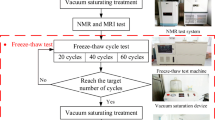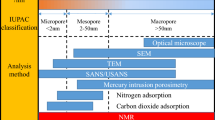Abstract
Multiple freeze–thaw cycle tests were conducted on sandstone samples. The sandstone samples were examined using X-ray diffraction (XRD) and nuclear magnetic resonance (NMR). The mineral content, porosity distribution, T2 (transverse relaxation time) spectral distribution, spectral area, and nuclear magnetic resonance imaging (MRI) data for sandstone samples were obtained, and the distribution and variation of the sample pores were analyzed. Uniaxial compression tests were performed on samples that had undergone 0, 20, 40, and 80 freeze‒thaw cycles, and the effects of freeze‒thaw cycles on the mass, compressive strength, and elastic modulus of the sample were analyzed. The damage evolution and strength degradation characteristics of sandstone after freeze‒thaw cycles were studied. As the number of freeze‒thaw cycles increases, mineral particle flaking and cracking appear on the rock surface, the uniaxial compressive strength and elastic modulus of rock samples decrease, and the typical stress–strain curve compaction stage corresponding to the deformation increases. According to the NMR T2 distribution, the pore size of rock samples increases after 80 freeze‒thaw cycles, especially that of medium-sized and small-sized pores. Meanwhile, the internal damage to the rock mass is a gradual process of cumulative fatigue damage caused by freezing and thawing, and the microscopic damage evolution law during freeze‒thaw cycles was revealed using MRI. Based on plasticity theory and damage fracture mechanics theory, the sandstone damage propagation criterion under freeze‒thaw-loading action was deduced, and a sandstone freeze‒thaw damage degradation model was established.



















Similar content being viewed by others
References
Abdolghanizadeh K, Hosseini M, Saghafiyazdi M (2020) Effect of freezing temperature and number of freeze–thaw cycles on mode i and mode ii fracture toughness of sandstone. Theor Appl Fract Mech 105:102428. https://doi.org/10.1016/j.tafmec.2019.102428
Al-Omari A, Beck K, Brunetaud X, Torok Al-Mukhtar M (2015) Critical degree of saturation: a control factor of freeze–thaw damage of porous limestones at Castle of Chambord. Eng Geol 185:71–80. https://doi.org/10.1016/j.enggeo.2014.11.018
Coates G, Xiao L, Prammer M (2007) NMR logging principles and application. Petroleum Industry Press, Beijing, pp 6–7
Gao F, Xiong X, Zhou K, Li J, Shi C (2019) Strength deterioration model of saturated sandstone under freeze-thaw cycles. Rock Soil Mech 40(3):926–932. https://doi.org/10.16285/j.rsm.2017.1886
Guo L, Yu Q, Yin N, Zhang D, Zhang D, Ren X, You Y, Zhang Z, Hu B, Chen S (2022) Effect of freeze–thaw cycle on hydraulic conductivity of compacted clayey soil. J Mt Sci 19(2):606–614. https://doi.org/10.1007/s11629-021-6683-9
Ishikawa T, Kawabata S (2016) Influence of freeze-thaw on the mechanical behavior of the granular base and fatigue life of pavement structures in Japan. Geo-china International Conference
Jamshidi A, Nikudel MR, Khamehchiyan M (2016) Evaluation of the durability of gerdoee travertine after freeze–thaw cycles in fresh water and sodium sulfate solution by decay function models. Eng Geol 202:36–43. https://doi.org/10.1016/j.enggeo.2016.01.004
Kellerer-Pirklbauer A (2017) Potential weathering by freeze-thaw action in alpine rocks in the european alps during a nine year monitoring period. Geomorphology 296:113–131. https://doi.org/10.1016/j.geomorph.2017.08.020
Lemaitre J, Dufailly J (1987) Damage measurements. Eng Fract Mech 28(5–6):643–661. https://doi.org/10.1016/0013-7944(87)90059-2
Li J (2012) Experiment study on deterioration mechanism of rock under the conditions of freezing-thawing cycles in cold regions based on NMR technology. Central South University, Changsha
Li J, Kaunda R, Zhu L, Zhou K, Gao F (2019a) Experimental study of the pore structure deterioration of sandstones under freeze-thaw cycles and chemical erosion. Adv Civ Eng. https://doi.org/10.1155/2019/9687843
Li J, Zhou K, Liu W, Deng H (2016) NMR research on deterioration characteristics of microscopic structure of sandstones in freeze–thaw cycles. Chin J Nonferrous Met 26(11):2997–3003. https://doi.org/10.1016/S1003-6326(16)64430-8
Li J, Zhu L, Zhou K, Chen H, Shen Y (2021) Non-linear creep damage model of sandstone under freeze-thaw cycle. J Cent South Univ 28(3):954–967. https://doi.org/10.1007/s11771-021-4656-3
Li X, Qu D, Luo Y, Ma R, Xu K, Wang G (2019b) Damage evolution model of sandstone under coupled chemical solution and freeze-thaw process. Cold Reg Sci Technol 162:88–95. https://doi.org/10.1016/j.coldregions.2019.03.012
Li Y, Tang D, Elsworth D, Hao X (2014) Characterization of coalbed methane reservoirs at multiple length scales: a cross-section from southeastern ordos basin, China. Energy Fuels 28(9):5587–5595. https://doi.org/10.1021/ef500449s
Li Z, Yang G, Liu H (2020) The influence of regional freeze–thaw cycles on loess landslides: analysis of strength deterioration of loess with changes in pore structure. Water 12(11):3047. https://doi.org/10.3390/w12113047
Lindner F, Wassermann J, Igel H (2021) Seasonal freeze-thaw cycles and permafrost degradation on Mt. Geophys Res Lett, Zugspitze (German/Austrian Alps) revealed by Single-station seismic monitoring. https://doi.org/10.1029/2021GL094659
Liu C, Wang D, Wang Z, Ke B, Yu S (2021a) Dynamic splitting tensile test of granite under freeze-thaw weathering. Soil Dyn Earthq Eng 140:106411. https://doi.org/10.1016/j.soildyn.2020.106411
Liu H, Yang G, Yun Y, Lin J, Ye W, Zhang H, Zhang Y (2020a) Investigation of sandstone mesostructure damage caused by freeze-thaw cycles via ct image enhancement technology. Adv Civ Eng. https://doi.org/10.1155/2020/8875814
Liu H, Yuan X, Xie T (2019a) A damage model for frost heaving pressure in circular rock tunnel under freezing-thawing cycles. Tunn Undergr Space Technol 83:401–408. https://doi.org/10.1016/j.tust.2018.10.012
Liu Q, Chen W, Guo J, Li R, Li X (2021b) Fractional stress relaxation model of rock freeze-thaw damage. Hindawi Limited. https://doi.org/10.1155/2021/3936968
Liu T, Wang Y, Zhou K, Gao F, Xie S (2019b) Research on the mechanical properties and nmr characteristics of cement mortar during freeze-thaw cycles. Adv Civ Eng. https://doi.org/10.1155/2019/6805480
Liu T, Zhang C, Cao P, Zhou K (2020b) Freeze-thaw damage evolution of fractured rock mass using nuclear magnetic resonance technology. Cold Reg Sci Technol 170:102951. https://doi.org/10.1016/j.coldregions.2019.102951
Liu T, Zhang C, Li J, Zhou K, Ping C (2021c) Detecting freeze–thaw damage degradation of sandstone with initial damage using nmr technology. Bull Eng Geol Env 80(6):4529–4545. https://doi.org/10.1007/s10064-021-02242-1
Luo X, Jiang N, Fan X, Mei N, Luo H (2015) Effects of freeze-thaw on the deterurination and application of parameters of slope rock mass in cold regions. Cold Reg Sci Technol 110:32–37. https://doi.org/10.1016/j.coldregions.2014.11.002
Meng Y, Jing H, Yuan L, Zhang L (2022) Numerical investigation on the effect of bedding plane properties on mode i fracture characteristics of mudstone with fem-czm method. Bull Eng Geol Env 81(1):1–18. https://doi.org/10.1007/s10064-021-02515-9
Momeni A, Abdilor Y, Khanlari G, Heidari M, Sepahi A (2016) The effect of freeze–thaw cycles on physical and mechanical properties of granitoid hard rocks. Bull Eng Geol Env 75(4):1649–1656. https://doi.org/10.1007/s10064-015-0787-9
Park J, Hyun C, Park H (2015) Changes in microstructure and physical properties of rocks caused by artificial freeze-thaw action. Bull Eng Geol Env 74(2):555–565. https://doi.org/10.1007/s10064-014-0630-8
Park K, Kim K, Lee K, Kim D (2020) Analysis of effects of rock physical properties changes from freeze-thaw weathering in Ny-angstrom lesund region: Part 1-Experimental Study. Appl Sci 10(5):1707. https://doi.org/10.3390/app10051707
Peng J, Wong LNY, Liu G, et al. (2019) Influence of initial micro-crack damage on strength and micro-cracking behavior of an intrusive crystalline rock. Bull Eng Geol Environ 78: 2957–2971. https://doi.org/10.1007/s10064-018-1317-3
Sokhansefat G, Moradian M, Finnell M, Behravan A, Ley MT, Lucero C, Weiss J (2020) Using X-ray computed tomography to investigate mortar subjected to freeze-thaw cycles. Cem Concr Compos 108:103520. https://doi.org/10.1016/j.cemconcomp.2020.103520
Su Z, Geng K, Zhou F, Sun J, Yu H (2021) Influence of freeze-thaw cycles on acoustic emission characteristics of granite samples under triaxial compression. Adv Civ Eng 3:1–11. https://doi.org/10.1155/2021/5571680
Wang B, Pan J, Fang R, Wang Q (2020a) Damage model of concrete subjected to coupling chemical attacks and freeze-thaw cycles in saline soil area. Constr Build Mater 242(6):118205. https://doi.org/10.1016/j.conbuildmat.2020.118205
Wang J, Liu Y, Tang D (2021a) Influence of freeze-thaw cycles on water content properties of silty clay in xuchang. IOP Conf Ser Earth Environ Sci 772(1):012104. https://doi.org/10.1088/1755-1315/772/1/012104
Wang J, Wang Q, Lin S, Han Y, Wang N (2020b) Relationship between the shear strength and microscopic pore parameters of saline soil with different freeze-thaw cycles and salinities. Symmetry 12(10):1709. https://doi.org/10.3390/sym12101709
Wang L, Chen W, Tan X, Tan X, Zhang X (2019) Numerical investigation on the stability of deforming fractured rocks using discrete fracture networks: a case study of underground excavation. Bull Eng Geol Environ 79:133–151. https://doi.org/10.1007/s10064-019-01536-9
Wang Y, Zhang B, Li B, Li C (2021b) A strain-based fatigue damage model for naturally fractured marble subjected to freeze-thaw and uniaxial cyclic loads. Int J Damage Mech 30(10):1594–1616. https://doi.org/10.1177/10567895211021629
Xu P, Wu Y, Wang Z, Huang L (2020) Distribution laws of freeze-thaw cycles and unsaturated concrete experiments in cold-region tunnels. Cold Reg Sci Technol 172:102985. https://doi.org/10.1016/j.coldregions.2019.102985
Yao Y, Liu D, Yao C, Tang D, Tang S, Huang W (2010) Petrophysical characterization of coals by low-field nuclear magnetic resonance (NMR). Fuel 89(7):1371–1380. https://doi.org/10.1016/j.fuel.2009.11.005
Yuan J, Ye C, Yang J, Xie Z, Liu J, Wang S, Liu Y (2021) Experimental and numerical investigation on the deterioration mechanism for grouted rock bolts subjected to freeze–thaw cycles. Bull Eng Geol Env 80:5563–5574. https://doi.org/10.1007/s10064-021-02279-2
Zhang Q, Yang G, Ren J (2003) A new discussion on rock damage variables and constitutive equations. Chin J Rock Mech Eng 22(1):30–34. https://doi.org/10.3321/j.issn:1000-6915.2003.01.005
Zhang Y, Xiao L (2006) Experimental study on nuclear magnetic resonance characteristics of rock under uniaxial loading. Nucl Electron Detect Technol 26(6):731–734. https://doi.org/10.1016/S1872-2040(06)60004-2
Zhou K, Su S, Hu Z, Li J, Yang Z (2015) NMR experimental study on unloading of marble under different initial damages. Rock Soil Mech 36(8):2144–2150. https://doi.org/10.16285/j.rsm.2015.08.003
Zhou L, Ma Z, Xie H, Yang W, Zheng H (2022) Numerical simulation experimental study of the deformation and failure of granite with multiaxial tension. Processes 10(5):949. https://doi.org/10.3390/pr10050949
Zhou X, Li C, Zhou L (2020) The effect of microstructural evolution on the permeability of sandstone under freeze-thaw cycles. Cold Reg Sci Technol 177:103119. https://doi.org/10.1016/j.coldregions.2020.103119
Funding
This study received funding from a project (52004327) supported by the National Natural Science Foundation of China.
Author information
Authors and Affiliations
Corresponding author
Rights and permissions
Springer Nature or its licensor holds exclusive rights to this article under a publishing agreement with the author(s) or other rightsholder(s); author self-archiving of the accepted manuscript version of this article is solely governed by the terms of such publishing agreement and applicable law.
About this article
Cite this article
Liu, T., Cui, M., Zhang, C. et al. Nuclear magnetic resonance analysis of the failure and damage model of rock masses during freeze‒thaw cycles. Bull Eng Geol Environ 81, 445 (2022). https://doi.org/10.1007/s10064-022-02944-0
Received:
Accepted:
Published:
DOI: https://doi.org/10.1007/s10064-022-02944-0




